Yves GARY Hits: 4637
Category: 1901 : CHALLENGE N°11
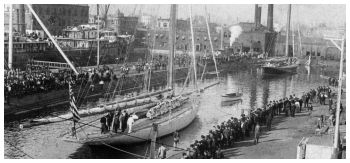 Final preparations
Final preparationsOn August 11th, at 11.30 P.M., Shamrock II passed Sandy Hook, a little less than sixteen days out from the Clyde. She was promptly taken to Erie Basin, where all challengers since Genesta had refitted, and there received her racing spars and gear, which arrived by steamer August 4th.
On August 14th she was docked, and American yachtsmen had an opportunity to look at the appearance of the yacht. Shamrock's trials in the neighborhood of Sandy Hook began August 22d, and were followed with deep interest by the public.
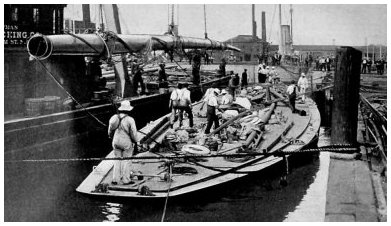 Her speed was described as marvelous, and press reports had her coming about in twelve seconds, and sailing a measured mile at the rate of fourteen knots, which were results she never attained in the cup races under exceptionally favorable conditions.
Her speed was described as marvelous, and press reports had her coming about in twelve seconds, and sailing a measured mile at the rate of fourteen knots, which were results she never attained in the cup races under exceptionally favorable conditions.
Shamrock II's tuning up in American waters was without special incident, except for a bad quarter-hour she had on September 12th, when caught in a squall. Capt. Sycamore's seamanship was criticized by American and English writers for his having allowed himself to be "caught afoul" in a tight place. Shamrock was taken to the Erie Basin dry-dock on September 15th, and by noon she was docked, her hull being exposed for the second time in this country. The bottom was in good condition, requiring only cleaning and polishing, and the replacing of several rivets. The yacht remained in dock more than a week.
On her arrival at New York Columbia was docked at the Morse Iron Works in South Brooklyn for polishing and painting. In the meantime it had become apparent that should the injuries of President McKinley, who was shot at Buffalo September 6th, prove fatal, the races would have to be postponed. The President died September 14th, and Sir Thomas Lipton at once proposed a postponement of the races.
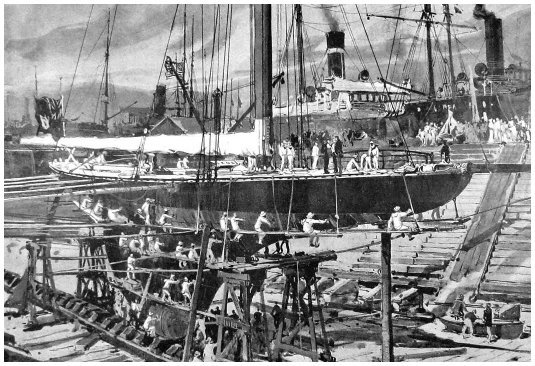 A meeting was held September 16th at the New York Yacht Club house, between the America's cup committee of the club and representatives of the Royal Ulster Yacht Club, at which it was agreed that the postponement of the first race should be for five days from September 21st, or to September 26th, the succeeding races to be sailed September 28th, October 1st, 3rd and 5th.
A meeting was held September 16th at the New York Yacht Club house, between the America's cup committee of the club and representatives of the Royal Ulster Yacht Club, at which it was agreed that the postponement of the first race should be for five days from September 21st, or to September 26th, the succeeding races to be sailed September 28th, October 1st, 3rd and 5th.
A few days before the races the coat of green paint on Shamrock's topsides was removed, except a narrow ribband at the sheer-strake, it being thought she would sail better without it. This incident illustrates the extreme view taken of the value of reducing friction. The entire hull of the boat was burnished like a metal mirror, the bronze taking a dull lustre of a yellowish-green tint. Equal care was taken in polishing the bottom plates of Columbia, but her topsides were again coated with pure white paint.
On September 24th the rival boats lay side by side at Erie Basin, and Mr. John Hyslop measured them. The results showed that Shamrock's allowance to Columbia would be forty-three seconds in thirty miles, which was much less than was expected by everyone except perhaps Mr. Watson.
 Publié le 25 sept. 1901 |
COLUMBIA'S SMALL ALLOWANCE OF TIME. |
||
The racers and their attendant vessels made a considerable fleet inside the Hook, and there was great activity on board them in preparation for getting under way for the first race.

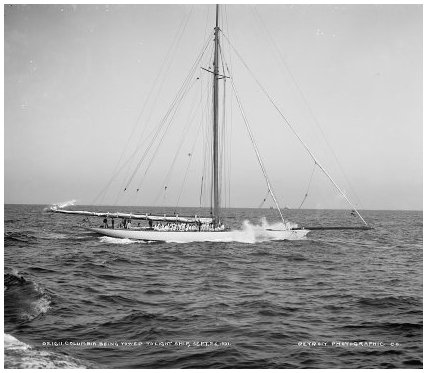 SEPT. 26, 1901 - YACHT RACE FAILED FOR LACK OF WIND
SEPT. 26, 1901 - YACHT RACE FAILED FOR LACK OF WIND Sept. 27, 1901The day of the first race, September 26th, dawned fine and warm, with a free air moving off Sandy Hook, the weather conditions being at their best for late September in the latitude of New York. A sepia mist lay over the city and New Jersey hills. Seaward a few fleecy clouds drifted out of the horizon and sailed southwest-ward as the morning grew older.
Sept. 27, 1901The day of the first race, September 26th, dawned fine and warm, with a free air moving off Sandy Hook, the weather conditions being at their best for late September in the latitude of New York. A sepia mist lay over the city and New Jersey hills. Seaward a few fleecy clouds drifted out of the horizon and sailed southwest-ward as the morning grew older.
When the yachts came out past the Hook in tow about 9.30 a breeze of twelve-knots' strength, from E. by N., picked up a sparkling chop on the long ocean swell heaving landward. A little later the wind dropped, and by 10.30 when the code signal giving the course was hoisted on the committee tug Navigator, it was scarcely ten-knots' strength.
The course, E. by N. fifteen miles, was logged by a tug, and a guide-tug was ready to steam over it in a straight line to show the racers the way. A patrol of government vessels similar to that of 1899 was early on the ground to assure a clear course. 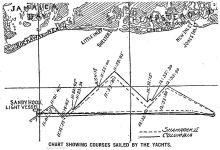 It consisted of six revenue cutters, and several smaller craft, assisted by a number of steam-yachts, large and small. No torpedo boats were employed, as in 1899. Capt. Thomas D. Walker, on the revenue cutter Gresham, was in command of the patrol fleet.
It consisted of six revenue cutters, and several smaller craft, assisted by a number of steam-yachts, large and small. No torpedo boats were employed, as in 1899. Capt. Thomas D. Walker, on the revenue cutter Gresham, was in command of the patrol fleet.
When the yachts cast off their towlines, and began to sail slowly about in the vicinity of Sandy Hook light-vessel, waiting the preparatory signal, they were observed with deep interest by the large number of persons on the attendant excursion fleet, and comparisons were made by no means derogatory to the challenging boat. To the layman's eye Shamrock II seemed larger and more powerful than Columbia.
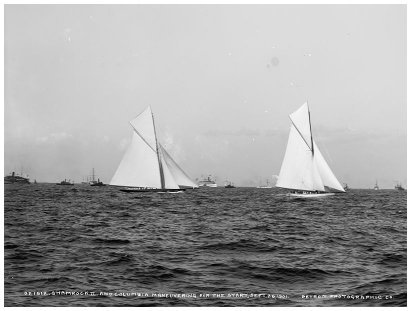 Her sails were loftier, and her hull longer and lower, with an appearance to leanness that seemed to indicate superior power and speed. The set of her sails was perfect, and being a fresh buff tint, they made with the dull yellowish-green of her hull a study in brown and olive, which contrasted strongly with Columbia's snow-white hull and no less purely white canvas. Critics averred that Shamrock's sails were too flat and firm to wrest speed from American breezes, but casual observers declared them perfect. Columbia wore her 1899 mainsail and new headsails. Each boat had her largest club-topsail aloft.
Her sails were loftier, and her hull longer and lower, with an appearance to leanness that seemed to indicate superior power and speed. The set of her sails was perfect, and being a fresh buff tint, they made with the dull yellowish-green of her hull a study in brown and olive, which contrasted strongly with Columbia's snow-white hull and no less purely white canvas. Critics averred that Shamrock's sails were too flat and firm to wrest speed from American breezes, but casual observers declared them perfect. Columbia wore her 1899 mainsail and new headsails. Each boat had her largest club-topsail aloft.
From the moment of their casting off towlines it was to be seen the vessels were more evenly matched than any other contestants for the cup, and that the struggle between them would be sharp and close. It began at 10.55, with the preparatory gun. The boats were then to southward of the line. With the gun they stood toward the line on the starboard tack, Columbia having the weather berth. For the next fifteen minutes their maneuvers were watched with breathless interest from the fleet.
Cleverer handling of ninety-footers had never been seen off Sandy Hook. Capt. Barr had an opponent worthy of his steel, and not afraid of him. The result was hair-lifting to novices. The yachts kept such close company that it seemed momentarily as if their spars or hulls must touch. They first came toward the line as noted, and crossed it. Shamrock luffing frequently and Columbia luffing with her. North of the line Shamrock wore ship. Columbia jibed with her, and maintained the weather berth. They then stood back across the line on the port tack, so close together that a clash seemed unavoidable. Some distance from the line Columbia hauled and tacked to starboard. Shamrock tacking also, with Columbia still on her quarter. Shamrock luffed, and so did Columbia, w ith the result that the latter crossed the line ahead of the starting gun, now nearly due.
Warned from the committee boat, the yachts fell off to leeward of the line, and stood along it until the gun was fired. Then they luffed to cross, and both went over the line, Columbia being timed as twelve seconds in the lead.
Unfortunately there was raised a question as to whether or not this gain was legitimate. The men in charge of Shamrock, according to press reports, subsequently stated that had they held to their rights and not given way, Capt. Barr could not have avoided fouling them at the start. 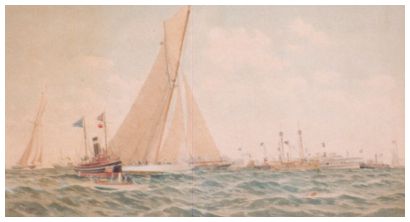 The question was the one which had so often risen earlier in the season in starts between Columbia and other vessels, as to whether the leeward yacht kept off voluntarily, or was forced to keep off to avoid a foul with the boat to windward. The captain of Shamrock stated he saw Columbia keep off, and he also kept off to escape collision, wishing to avoid the unpleasantness of a foul at the beginning of the series. Capt. Barr might have luffed on finding himself across ahead of the gun, and wore ship to get back of the line, but it is probable that in luffing he would have fouled Shamrock in the same manner he fouled Independence off Newport; and as Capt. Sycamore gave way, it appears that Capt. Barr found it easier to keep off, and at the same time hold his advantage.
The question was the one which had so often risen earlier in the season in starts between Columbia and other vessels, as to whether the leeward yacht kept off voluntarily, or was forced to keep off to avoid a foul with the boat to windward. The captain of Shamrock stated he saw Columbia keep off, and he also kept off to escape collision, wishing to avoid the unpleasantness of a foul at the beginning of the series. Capt. Barr might have luffed on finding himself across ahead of the gun, and wore ship to get back of the line, but it is probable that in luffing he would have fouled Shamrock in the same manner he fouled Independence off Newport; and as Capt. Sycamore gave way, it appears that Capt. Barr found it easier to keep off, and at the same time hold his advantage.
Once over, Columbia, which was going the faster, luffed sharply and threw a back draft into Shamrock's sails, deadening the challenger's speed somewhat. Shamrock tacked to port under the defender's stern, and thus the race began. Columbia at once went after her rival, which seemed to start off at a much faster pace, raising fears in the hearts of some of the patriots that Columbia could not hold her.
After the first five minutes of sailing the challenger seemed to go slower, and Columbia, favored by a puff, worked out on her weather. The wind was now not more than seven knots and falling, with streaks of strength that favored first one vessel, then the other. Columbia made easier progress on the long swell. 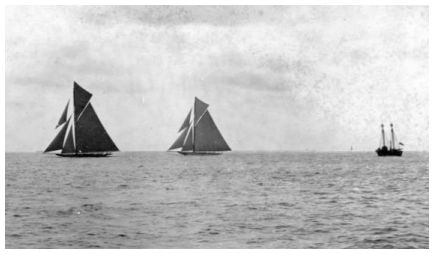 She also seemed to pinch higher into the wind in the puffs, and to get more benefit from them than her rival, through careful trimming of her sails and more responsive steering. Shamrock's sails seemed to be trimmed down too flat, and she was sent straight ahead, while her opponent headed up strongly in all puffs.
She also seemed to pinch higher into the wind in the puffs, and to get more benefit from them than her rival, through careful trimming of her sails and more responsive steering. Shamrock's sails seemed to be trimmed down too flat, and she was sent straight ahead, while her opponent headed up strongly in all puffs.
At 11.41.35 the vessels approached one another on opposite tacks, and Columbia, on the port tack, crossed Shamrock's bow, about one hundred and fifty yards ahead. About an hour later, Shamrock, by a bit of good fortune, was enabled to turn the tables. The course of the yachts lay towards the Long Island shore, down which the turn was marked. At 12.45.30 Columbia tacked offshore to port, and Shamrock started to follow, but failed to come about in the very light wind. She therefore fell off again on the same inshore tack, where in a short time she caught a considerable air. At the same time Columbia was in a "soft spot" seaward. The outcome was a gain for Shamrock which enabled her, when the boats next came into company, to cross Columbia's bow and tack on her weather.
The advantage thus gained was not held, for the breeze strengthening after one o'clock, Columbia pulled through Shamrock's lee, and by luffing tried to move out to windward of her. A number of short tacks followed, resulting in the American boat obtaining the weather berth, which she easily held. The outer mark was rounded with Columbia 7 m. 15s. ahead of Shamrock. The wind hauled to the south after the mark was turned, and fell lighter and lighter. At 4.40 the race was declared off, the time limit having expired. Columbia was then eight miles from the finish, and perhaps a mile ahead.
| The summary : |  |
The day's sailing dampened the ardor of Shamrock's backers, and reassured Columbia's friends. The challenger appeared slower in stays and not so lively in light winds as the defender; and though splendidly sailed, there was a shade of inferiority in her handling that told against her. That night Sir Thomas Lipton told the press representatives that with a breeze of from ten to twelve knots Shamrock would do much better.
